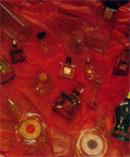The Caribbean’s top-twelve scents
In any Caribbean perfume store, regardless of brands and makes, both local and foreign travelers go for natural scents as a token of good smelling sensitivity: taste, desire, sensuality and, above all, cultural identification. It's seen as a way to feel the weather, to cotton on to the human body, let alone being a style of spirituality in which nature is a key player.
Smells breezing in from the sea get mixed up with those of the vegetation, a combination that stamps the very special and commonplace seal of the Antilles, either Lesser or Greater, as if it were some sort of hushed musicality, mute and psychedelic at one fell swoop, that serves to resemble the shaking gaudiness of the entire region.
Essences of Essences Natural perfumes, as the words indicate, are smells that can be obtained in sync with what Mother Nature provides us with. That is, scents from plants, chiefly flowers, stems and leaves, whose contents have specific smells that can be used in the making of perfumes.
A person with vast expertise in this particular field is Cuban perfume maker Yanelda Mendoza, a woman who's been working for quite a number of years in a conspicuous store known as Havana 1791.
For Mrs. Mendoza, and for lots of other experts, people from balmy-weather countries like to spritz refreshing fragrances on them, chiefly those well-known eau de colognes that now glut the markets. However, there's an assortment of nice whiffs like those from citrus fruits: orange, lemon and lime; and others extracted from such flowers as rose, jasmine and violet.
That explains why every time a traveler comes up to this showcase, he immediately gets in touch with twelve scents, a dozen fragrances that make the rounds in other nations and call Havana their home.
These twelve perfumes we're talking about are: Rose, Violet, Lila, Jasmine, Lavender, Bergamot Mint, Vetiver, Tobacco, Citron Blossom, Patchouli, Lemon and Ilan-Ilan.
In an effort to trace their origin, these twelve scents have been registered for over a decade now on behalf of the City of Havana Historian's Office and are by far the most sought-after essences by tourists from everywhere under the sun that walk into this peculiar establishment also serving as a museum.
A little bit of history Thanks to their senses, human beings communicate with one another and one key role here is played by the sense of smell. That's why perfumes are high on the list of powerful products when it comes to public relations.
On the other hand, the sense of smell is a knee-jerk maker of connections and emotions. Perfumes pack a punch for creating an image of the person that wears them. Make no mistakes about it; any scent rubber-stamps a seal of its own on a certain individual.
As a result of this, perfumes have existed ever since man was gifted with a sense to sniff at things. The legend goes that Caribbean's aboriginal people were highly concerned about the way they smelled and used to rub some plants all over their bodies in order to look better among their peers and reflect a care for cleaning.
Fragrances hopped from the East to Egypt, where those who had water used to pour scents in their baths and smear an assortment of oils to attract the gods. As far as medicine is concerned, some old records have it that Hippocrates used a certain amount of plants to fight back diseases and take advantage of their healing powers.
The Arabs developed the industry of perfume making to the utmost by combining certain potions with the help of alchemy, a method they resorted to time and again to squeeze off quintessence from plants. However, the year 1200 was the time when the takeoff in terms of perfumes and scents finally came to pass. In an unprecedented event up to that very moment in the history of mankind, King Felipe II granted rights on the sale of fragrances and officially recognized the trade of perfume making. The subsequent development of this industry led in 1893 to the discovery of ionone, a substance whose smell matches almost perfectly with that of violet. A non-natural kind of perfume making was born and the cost of production was cut back dramatically.
Summing things up, there's no doubt in anyone's mind that France is the cradle of perfumes, a country that, for a number of social reasons, remains deeply involved in the most avant-garde concerns toward the achievement of ultimate luxury and the development of the society.
Even though there are countless world-class brands and trademarks in the realm of today's perfumes, there are patios and gardens in Latin America where travelers from around the globe can breathe in delicious fragrances wafting around from natural essences.
Willing to win back those fragrances, experts at Havana 1791 have done a research study on the twelve most coveted scents in the Caribbean region. Today, an increasingly larger number of visitors comes to the store's showcases lured not only by the exquisite aroma of these fragrances, but also by the purpose of taking in their bags a tiny sample of the essences that reign in this warm neck of the woods.






































































